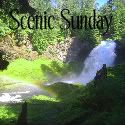I am pleased to announce that, finally, this is the last entry (part 4) of the Buddhist Guardian series. I am sure that all of you guys are relieved to hear that.
He is "
The last Statue Standing", named
Abatsumara (
阿跋摩羅), one of the four Guardians at
Yashamon Gate (
夜叉門) of
Taiyuin (
大猷院) at the
World Heritage site in
Nikko city, Tochigi Prefecture. Taiyuin is a Buddhist temple at which the 3rd Tokugawa Shogun,
Iemitsu Tokugawa (
徳川家光) is worshipped.
Abatsumara is not as explicit as
Kendara, but more than
Bidara and
Umarokya. Like
Kendara, his knees are naked, whereas in the case of
Bidara and
Umarokya, their knees have companion kneepads of catfish and elephant, respectively.
He holds a
golden stick in his right hand as a weapon and his left forefinger is pointing upward (toward heaven?). I am not sure of the significance of this pose...
Let's take a closer look at him.
 |
| Close-up view of his face |
 |
| Close-up view of his waist |
|
His orange hair is all standing up. Unlike others, he has no fierce fangs but shining white teeth. Well, his eyebrows need to be trimmed... Note the skin of white tiger around his waist. It's a unique feature of him. He does not have a pair of shoes.
He's a guardian of the "East".
Before ending this series, I would like to mention the background, which is carved with flowers. Can you tell what these flowers are?
 |
| Lower one is covered with Goldl!!! |
They are all Peonies that appear behind all of the four statues. I am not certain why peony was chosen. Anyway, based on that, Yashamon Gate is also called Botanmon gate (牡丹門; Botan - Peony, Mon - Gate).
 |
| Tokugawa Clan's Emblem |
Can you see the emblem above? I know it's hard to find but it is the
emblem (家紋) of the
Tokugawa clan (徳川氏).
All right. That's it!
Thanks for your patience.
This is a
Alphabe-Thursday entry. "
N" is for
Nikko.
If you haven't seen his friends, be prepared to be thrilled!
 |
| Umarokya |
 |
| Bidara |
 |
| Kendara |












































